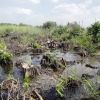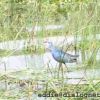මුතුරාජවෙල
In Sri Lanka there are many types of wetland, as estuaries, lagoons, sea grass beds, mangroves and marshes. These areas are of immense environmental, economic and social importance, yet not valued by most. Part of the marsh known as Muthurajawela near Negombo is a protected area open to the public. Muthurajawela literally means “swamp of pearls” in Sinhalese.
There was probably an ancient legend connected with royalty and hoards of plundered riches that earned it this name Muthurajawela and it is definitely a treasure trove, not of pearls, but of natural wonders fighting to survive at the edge of a city. A trip by boat makes an exploration of the marsh and seeing the rich bird life and a rare reptile.
the public. Muthurajawela literally means “swamp of pearls” in Sinhalese. There was probably an ancient legend connected with royalty and hoards of plundered riches that earned it this name Muthurajawela and it is definitely a treasure trove, not of pearls, but of natural wonders fighting to survive at the edge of a city. A trip by boat makes an exploration of the marsh and seeing the rich bird life and a rare reptile.
Muthurajawela marsh is believed to have originated around 5,000 BCE. There is also evidence of extensive paddy farming in the area some 500 years ago. Today the marsh together with the Negombo Lagoon forms an integrated coastal ecosystem of 6,232 hectares. Muthurajawela itself spreads all the way south from the lagoon to the Kelani Ganga (River), situated at the northern tip of Colombo.
It has an amazing 192 species of flora and 209 species of vertebrate fauna. Birds constitute a large portion of the latter with 102 species is recorded of which 19 are migratory. No less than 16 different species of mangrove can be found at Muthurajawela, making it an important refuge for this threatened plant. 40 different species of fish are found, of which 15 are endemic. Among the predators are crocodiles, monitor lizards, pythons – the Sri Lanka’s largest snake and fishing cats. The occurrence of the star tortoise is of particular interest as this species is known to occur naturally only in the low country dry zone and intermediate zone; not in a steaming wetland like Muthurajawela. Muthurajawela has a system of channels and footpaths. There is also a canal built during the Dutch occupation of the country. The easiest way of getting about the marsh is to turn up at the Muthurajawela Marsh Centre and let the helpful staff take it from there.
Listing Details
Mobile
+94 77 888 5552







